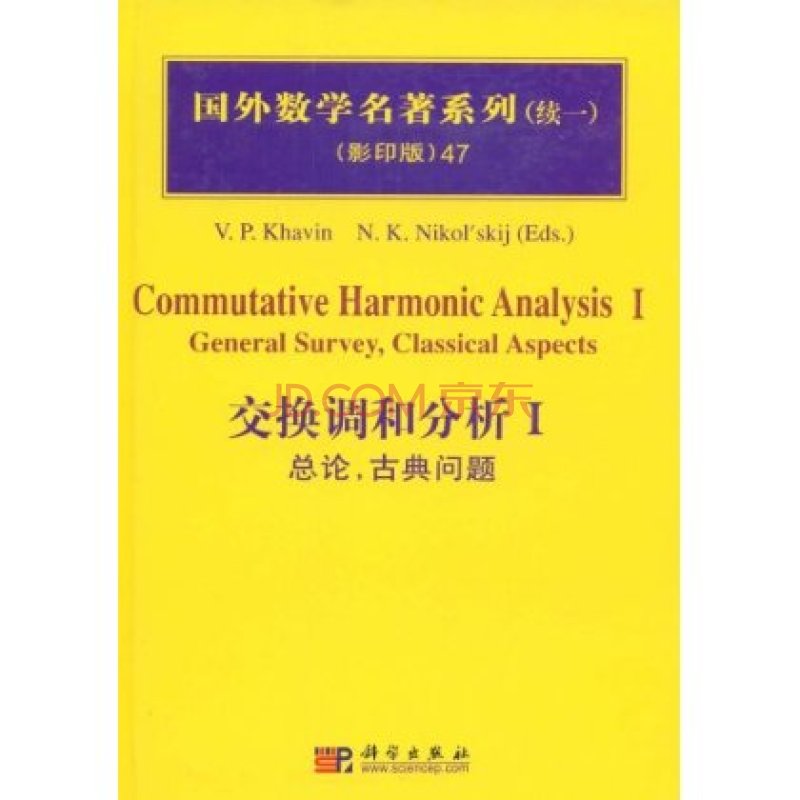《國外數學名著系列47:交換調和分析1》是2009年1月1日科學出版社出版的圖書。
基本介紹
- 中文名:國外數學名著系列47:交換調和分析1
- 外文名:Commutative Harmonic Analysis I: General Survey, Classical Aspects
- 出版社:科學出版社
- 精裝:268頁
圖書信息,作者簡介,內容簡介,目錄,
圖書信息
叢書名: 國外數學名著系列(續一)(影印版)47
正文語種: 英語
開本: 16
ISBN: 9787030234902
條形碼: 9787030234902
尺寸: 24 x 17.2 x 2 cm
重量: 581 g
作者簡介
作者:(俄羅斯)哈文 (V.P.Khavin) (俄羅斯)N.K.Nikol'skij
內容簡介
《國外數學名著系列(續1)(影印版)47:交換調和分析1(總論,古典問題)》主要內容包括:The first volume in this subseries of the Encyclopaedia 1S meant to familiarize the reader with the iscipline Commutative Harmonic AnalysiS.The first article is a thorough introduction,moving from Fourier series to the Fourier transform,and on to the group theoretic point ofview.Numerous examples illustrate the connections to differential and integral equationS,approximation theory,nutuber theory, probability theory and physics.The development of Fourier analysis is discussed in a brief historical essay.
The second article focuses on some of the classical problems of Fourier series;it’S a"mini-Zygmund”for the beginner.The third article is the most modern of the three,concentrating on singular integral operators.It also contains an introduction to Calderon-Zygmund theory.
目錄
Introduction
Chapter 1.A Short Course of Fourier Analysis of Periodic Functions
§1.Translation-Invariant Operators
1.1.The Set up
1.2.Object ofInvestigation
1.3.Convolution
1.4.General Form oft.i.Operators
§2.Harmonics.Basic Principles of Harmonic Analysis on the Circle
2.1.Eigenvectors and Eigenfunctions of t-i.Operators
2.2.Basic Principles of Harmonic Analysis on the Circle T
2.3.Smoothing ofDistributions
2.4.Weierstrass'Theorem
2.5.Fourier Coefficients.The Main Theorem of Harmonic Analysis on the Circle
2.6.Spectral Characteristics of the Classes * and *
2.7.L2-Theory of Fourier Series
2.8.Wirtinger'S Inequality
2.9.The lsoperimetric Inequality.(Hurwitz'Proof)
2.10.Harmonic Analysis on the Torus
Chapter 2.Harmonic Analysis in Rd
§1.Preliminaries on Distributions in Rd
1.1.Distributions in Rd
§2.From the Circle to the Line.Fourier Transform in Rd(Definition)
2.1.Inversion Formula(An Euristic Derivation)
2.2.A Proofofthe Inversion Formula
2.3.Another Proof
2.4.Fourier Transform in Rd(Definition)
§3.Convolution(Definition).
3.1.Difficulties of Harmonic Analysis in Rd
3.2.Convolution of Distributions(Construction)
3.3.Examples
3.4.Convolution Operators
§4.Convolution Operators as Object of Study(Examples)
4.1.Linear Ditierential and Difference Operators.
4.2.Integral Operators with a Kernel Depending on Difference of Arguments.
4.3.Integration and Differentiation of a Fractional Order.
4.4.Hilbert Transform
4.5.Cauchy'S Problem and Convolution Operators
4.6.Fundamental Solutions.The Newtonian Potential
4.7 Distribution of the Sum of Independent Random Variables
4.8 Convolution Operators in Approximation Theory
4.9.The Impulse Response Function ofa System.
§5.Means of InVestigation-Fourier Transform(S′-Theory and L2-Theory
5.1.Spaces S and S′
5.2.S′-Theory of Fourier Transform.Preliminary Discussion
5.3.S′-Theory of Fourier Transform(Basic Facts)
5.4.L2 Theory.
5.5.“x-Representation”and“”
§6.Fourier Transform in Examples
6.1.Some Formulae
6.2.Fourier Transform and a Linear Change of Variable
6.3 Digression:Heisenberg Uncertainty Principle
6.4.Radially-Symmetric Distributions
6.5 Harmonic Analysis of Periodic Functions
6.6.The Poisson Summation Formula
6.7.Minkowski'S Theorem on Integral Solutions of Systems of Linear Inequalities.
6.8.Jacobi's Identity for the
6.9.Evaluation ofthe Gaussian Sum.
§7.Fourier Transform in Action.Spectral Analysis of Convolution Operators
7.1.Symbol
7.2.Construction of Fundamental Solutions
7.3.Hypoellipticity
7.4 Singular Integral Operators and PDO
7.5 The Law of Large Numbers and Central Limit Theorem
7.6.
7.7.Tauberian Theorems
7.8.Spectral Characteristic of a System.
7.9. More on Summation Methods
8. Additional Remarks
8.1. Fourier Transform in. Ultra-Distributions
8.2. Certain Generalizations of the L2-Theory
8.3. Radon Transform
Chapter 3. Harmonic Analysis on Groups
1. An Outline of Harmonic Analysis on a Compact Group
1.1. A New Set Up
1.2. Harmonics
1.3. Representations
1.4. The Peter-H. Weyl Theorem
2. Commutative Harmonic Analysis
2.1. Simplifications Implied by Commutativity
2.2. Fourier Transform of Measures and Summable Functions
2.3. Convolution
2.4. Uniqueness Theorem. The Inversion Formula
2.5. Classical Harmonic Analysis from a General Point of View
2.6. Fast Multiplication of Large Numbers
2.7. Plancherel's Theorem
2.8. The Theorem of Bochner and A. Weil
3. Examples
3.1. Pontryagin's Duality Theorem
3.2. Almost Periodic Functions
3.3. Quadratic Reciprocity Law
4. Unitary Representations of the Group R
4.1. Stone's Theorem
4.2. Infinitesimal Generator
4.3. Examples
Chapter 4. A Historical Survey
Chapter 5. Spectral Analysis and Spectral Synthesis. Intrinsic Problems of Harmonic Analysis
1. Harmonic Analysis "For Itself"
2. Spectral Analysis
2.1. Linear Combination of Exponentials
2.2. Generalizations
2.3. Spectrum
3. Spectral Synthesis
3.1. Methods of Synthesis
3.2. Spectral Analysis-Synthesis of t.i. Operators According to L. Schwartz
3.3. Continuation, Periodicity in the Mean and Stability
3.4. Problems of Translation
3.5. Exceptional Sets
4. Translation-Invariant Operators. Singular Integrals, Multipliers
5. Complex-Analytic Methods
Epilogue
Bibliographical Notes
References

